Canadian sci-fi TV show Continuum finished up its first series in August, and is now broadcasting in the UK. It tells the story of a future cop, Kiera Cameron, trapped in present day Vancouver. The studio behind the visual effects – around 700 shots for the first ten episodes – is Artifex Studios, and we talk to VFX supe Adam Stern about the work.
fxg: Tell me about your involvement with Continuum?
Stern: Continuum is one of my favorite projects I’ve worked on in the past few years. One of the great things about the show is that we were invited into the fold as a collaborative partner. That can be said a lot and doesn’t always come into fruition, but we came into the project and from the get-go we were very involved in concept design, and throwing them at the showrunner. It’s really been a thrilling show to work on, and we’ve recently been told we’re going into a second season.
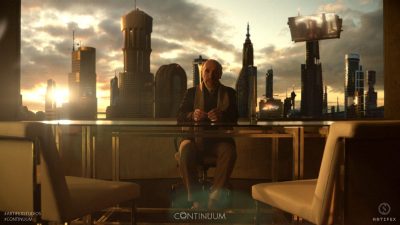 fxg: What environment work did you have to do, and what kind of shooting set-up did they have?
fxg: What environment work did you have to do, and what kind of shooting set-up did they have?
Stern: The show takes place in 2012 and then jumps to 2077, so one of the main aspects of our work was we had to take Vancouver as it exists now and re-map it to how it could look to 65 years from now. One of the pleasures of the show is that Vancouver truly plays itself in the show, and we were able to play with landmarks and things in the city without having to hide them. For example, there’s a dam now that spans across English Bay here, but because of floodwaters and climate change in the future there is flooding and what not.
So there were two things we did. We extended location photography, and the other stuff was pure 3D city work. We started with a map of Vancouver and blocked out the entire city so we could put the camera anywhere. The thought was that as we did shot-specific work, areas of the city would become more and more refined with detail. Then as the show went on we’d be able to put our cameras in more and more places.
fxg: Is this a show that relied on previs and early comps?
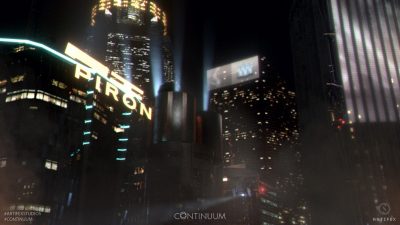
Stern: For sure, that was something that was very helpful. Also, because we knew where our location was, as we were doing our visual effects work for the pilot I was pulled aside and told by the creators of the show that they were going to be re-visiting this same set-up in the finale, and we had an opportunity to think about the scenes then. So while we were on set for the pilot we were able to previs and hide things in there that if you look carefully you’d see in the finale episode.
fxg: What tools were you using for the cityscapes?
Stern: It varied a lot. We got a little concerned when we first started that RenderMan might not be the right tool for Continuum, because it was all hard surface raytracing GI kind of stuff. So we thought we needed to look at Mental Ray, and started transitioning out of that to V-Ray at the end of the season, which will really help for the second season.
The most successful city shots for me were the ones where I went up on buildings in and around Vancouver with my 5D and did lots of photography and used that as the basis for the 3D work. Even if a lot of the photography didn’t end up in the shot, it gave that reference and the natural lighting in the sky. All the night city CG shots are completely manufactured in Maya, Mental Ray and Nuke. A typical shot involved going up to a building at dusk, shooting lots of photography, projecting, painting, adding 3D, adding billboards and then doing the camera moves.

fxg: There are shots in the show of buildings falling and destruction work – can you talk about those?
Stern: We relied mostly on dynamics in Maya for those, but for future shots I think we’ll look into something like Houdini which we don’t currently have in our pipeline. We’ve recently been beta testing Phoenix from the Chaos Group to do fluid and smoke work.
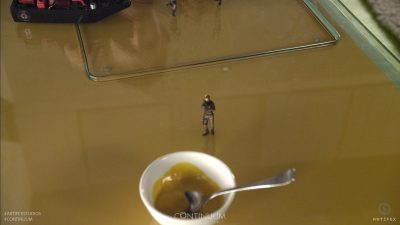
fxg: Another cool shot is the toy soldiers on the table.
Stern: Yes, there was a guy the production was working with – in ZBrush, he modeled up a couple of the little toy soldiers and he sent us his files (which had been used to fabricate the props that the boy is playing with). We re-topologized the model and placed it in the shot with our 3D version and walked them across the table.
fxg: How were you accomplishing the hologram effects?
Stern: A lot of that stuff is started and finished in Nuke, but a fair amount is done in After Effects. It comes into Nuke as two-and-a-half-D on a card or is corner pin tracked into the shot.
fxg: There’s also the projection and point cloud sequence, what’s the background behind those?
Stern: In the show, there’s a fancy suit that is basically a super-computer. They work out how it can be tied into cell phones and satellites. So at one point the main character is standing looking at a building and using the cellular waves in and around the building. As they wash over things she’s reconstructing the image. There was lots of talk about doing it almost like a pseudo-LIDAR scan. For the exterior shot of the building we modeled that in 3D, we shot a bunch of the artists here against greenscreen and comp’d them in as if they were being seen through the walls. In the apartment we used a repeatable head and did multiple passes of the room. We then modeled the room and our effects TD here did point cloud renders, and then we made it look like there was this wash of data coming over everything. Then the conceit was that she walks through it which was a stylistic choice.

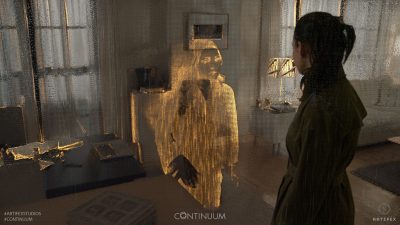
fxg: How did you do the flipping gun?
Stern: Back before we even went to tender on the show, they had shared an idea about a really cool gun where she basically has what just looks like the hand grip that is velcroed to her suit and then it unfurls – we called it the ‘Kerklack’. And we were asked to design it. Our matte painter and concept designer here drew a bunch of thumbnails of guns and they picked the one they liked and we went for a high-tech version of a six-shooter. The fun part of this was that instead of a prop informing what we were doing in visual effects, we took our 3D design, we modeled it and then it was printed in 3D to create the basis for the prop she held. The actress had two props to work with – the hand grip and the full extended gun. And then the hand grip model had LED tracking lights built into it so when she pulls it into frame and we had a model that we knew would perfectly track onto it and we had an animation cycle of it unfolding. It’s completely physically impossible what it does, but it looks cool!
fxg: How was the digital makeup work done for the older actor?
Stern: That was one of those times where I got asked to age one of the main actors. It was very important to maintain his likeness. They brought in the makeup effects guy and he told them what it would cost, and they all went pale. So they turned to me and asked what did I think I could do? In a crazily lucky moment of inspiration I suggested we shoot an older actor who somewhat reasonably matched our main guy.
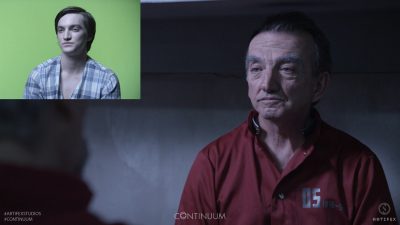 We then shot the older actor in context in the set lighting and then later shot the main actor. We took the footage of our older actor, and we put it in a switcher and put the main actor on greenscreen and as close as he could he duplicated the performance. In retrospect we would have done it in reverse but the schedule didn’t allow it. Then we took parts of the main actor’s face and warped and morphed them into the older actor’s performance so we could define the right parts of the face. So it’s basically a combination of two performances, and almost entirely comp work.
We then shot the older actor in context in the set lighting and then later shot the main actor. We took the footage of our older actor, and we put it in a switcher and put the main actor on greenscreen and as close as he could he duplicated the performance. In retrospect we would have done it in reverse but the schedule didn’t allow it. Then we took parts of the main actor’s face and warped and morphed them into the older actor’s performance so we could define the right parts of the face. So it’s basically a combination of two performances, and almost entirely comp work.
fxg: That seems to illustrate how diverse the work was.
Stern: Yeah, there’s that work and the cities, then all the high-tech stuff with gadgets and vehicles. Plus all the shots in current day with comp and clean-up. It really is a very diverse show to work on.

Does anyone have the same problem as i do? Cant watch it on my ipad… Both using ios 5 and 6…
Brilliant work from Artifex Studios. The cityscapes, motion graphic overlays, and the aging work look excellent. I have to check out this series.